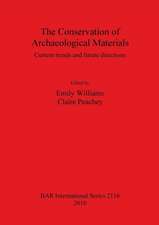Urban Development and Regional Identity in the Eastern Roman Provinces, 50 BC - AD 250: Aphrodisias, Ephesos, Athens, Gerasa
Autor Rubina Rajaen Limba Engleză Hardback – 14 mar 2012
This carefully researched study examines the instrumental factors behind urban development in four cities of the eastern Roman Empire, providing a regionally nuanced look at the prevailing economic, political, cultural, and social forces of the time. Rubina Raja discovers a profound understanding of self-representation in the public building projects that local communities executed within the larger framework of the Roman Empire, showing how regional leaders incorporated Roman culture with their own history and traditions in their urban designs. Also examining the economic impact of liberated imperial slaves and individual philanthropy, this study offers important insights into the interactions between the built environment and culture, showing the ways they create authentic urban identities."
Preț: 414.29 lei
Preț vechi: 505.71 lei
-18% Nou
79.30€ • 86.17$ • 66.65£
Carte disponibilă
Livrare economică 01-15 aprilie
Specificații
ISBN-10: 8763526069
Pagini: 273
Ilustrații: 59 color plates, 30 drawings, 6 maps
Dimensiuni: 171 x 241 x 25 mm
Greutate: 0.89 kg
Editura: Museum Tusculanum Press
Colecția Museum Tusculanum Press
Notă biografică
Cuprins
Acknowledgements
List of abbreviations
1. Introduction
2. Aphrodisias
The history and archaeology of the urban development of Aphrodisias from the late republican period to the mid-third century AD
The development of the major public spaces in Aphrodisias
Public spaces and regional identity in Aphrodisias
3. Ephesos
Ephesos in the late republican period
Ephesos from the reign of the Augustus to the mid-third century AD
Urban development in the late republican and early imperial periods
Urban development from the late first century to the mid-third century AD
Urban development and regional identity in Ephesos
4. Athens
Athens—historical outline
General topography and the urban plan
The Athenian agora and the Acropolis—developments of the late republican and early imperial periods
Other developments of the imperial period
Athens in the Hadrianic period
The development of public spaces and regional identity in Athens
5. Gerasa
General topography and the urban plan
The history and urban development of Gerasa in the late Hellenistic and early imperial periods
The history and urban development of Gerasa from the mid-first century AD to the mid-third century AD
The architectural development of the Sanctuary of Zeus
The architectural development of the Sanctuary of Artemis
Regional identity and urban development in Gerasa
6. Regional Identity and Urban Development in the Eastern Roman Provinces—Synthesis and Comparison
The cities and their development
Agoras
Basilicas, freestanding stoas, porticoes and colonnaded streets
Streets
City walls
The main urban sanctuaries
Theatres
Bouleuteria and odeia
Baths
Stadia, hippodromes and circuses
Arches and gates
Conclusion
Bibliography
Index
Recenzii
Descriere
This carefully researched study examines the instrumental factors behind urban development in four cities of the eastern Roman Empire, providing a regionally nuanced look at the prevailing economic, political, cultural, and social forces of the time. Rubina Raja discovers a profound understanding of self-representation in the public building projects that local communities executed within the larger framework of the Roman Empire, showing how regional leaders incorporated Roman culture with their own history and traditions in their urban designs. Also examining the economic impact of liberated imperial slaves and individual philanthropy, this study offers important insights into the interactions between the built environment and culture, showing the ways they create authentic urban identities."





